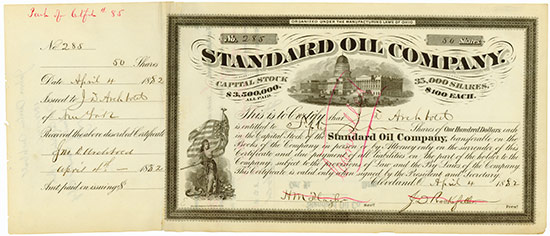Standard Oil Company
- Description
- Cleveland, Ohio, 1870th/1880th, Shares á US-$ 100, signed by John D. Rockefeller
- Business
- Oil
- Assignment
- North America
- Country
- United States
- Rarity Code
- 5
- Last Price
- €4,100.00
History
During his formative years, John D. Rockefeller – born in 1839 – managed to save 1,000 Dollars, a small fortune at that time. In 1859, he borrowed the same amount from his father and opened a brokerage firm with Maurice B. Clark. Very soon, they received orders for oil drilling in Pennsylvania. In 1863, they added Samuel Andrews as partner and from then on operated under Andrews, Clark & Co. They were then less interested in new capital but in Andrew’s patent for refinement of crude oil into benzin. Since the company took in more partners, a quarrel ensued over the ongoing company management; as a result, the company was auctioned off to the highest bidder. Rockefeller’s bid of 72,500 Dollars was accepted. Afterwards he made Andrews his partner again. One year later, they bought two refineries in Cleveland. Because of the received patents, they were now the only refinery, which could manufacture benzin, heating oil and petroleum. In 1870, Rockefeller together with his brother William, Henry M. Flagler, and a few others founded the Standard Oil Company. The company incorporated, partially through third companies, the largest part of the competition. Already at the end of the 1870s, the Standard Oil Company controlled 90 per cent of the American oil production. Later on, the shares of the 37 partial owners were brought into Standard Oil Trust, which had nine trustees – led by John D. Rockefeller. In 1890, the state of Ohio issued the „Sherman Act“ against the company, which led to its divestiture. Because New Jersey had another jurisdiction, Rockefeller relocated the company there. Henceforth, the company was called „Standard Oil Company of New Jersey“. In 1911, Rockefeller retired from managing the company. However, in the same year the Supreme Court ordered the divestiture into 38 independent companies. Exxon and Mobil were one of the companies among others. Paradoxically, just a few years ago, the cartel authority allowed the fusion of both of these companies to ExxonMobil. With a clever trick, Rockefeller opened up the huge China market: He presented kerosene lamps named Mei Foo to the Chinese. They were supposed to replace the old lamps, which were operated with vegetable oil. The Chinese then were forced to buy the necessary kerosene from Standard Oil. John Davison Rockefeller died on May 23, 1937 at the age of 97. At that time, his assets were estimated to be about 10 billion dollars. Henry M. Flagler had already slowly pulled away from the oil business in 1883 and engaged himself in Florida, which at that time, was still largely uninhabited. He built splendid hotels and amusement parks and planned the necessary infrastructure. The legendary Florida East Coast Railway built by Flagler was the first rail line, which connected larger cities of the East coast of the sunshine state. Only through these activities Florida was opened for tourism. Flagler died, highly revered as „Founder of Florida“ in West Palm Beach, where his palace – like home today serves as a museum in his honor. Next to the Rockefellers, Flagler and Rogers, John D. Archbold (1848-1916) is considered a dominating personality in the history of Standard Oil. Archbold had once defeated the South Improvement Company. However, only a little later he supported his former opponent in the attempt to monopolise the entire oil industry. After 1882, Archbold’s influence on the trust’s fate increased more and more. He always maintained an unconditional loyalty to John D. Rockefeller, especially in delicate situations. For that reason he succeeded Rockefeller as head of the world’s largest oil trust in 1911, after the foundation of the Standard Oil Company of New Jersey
